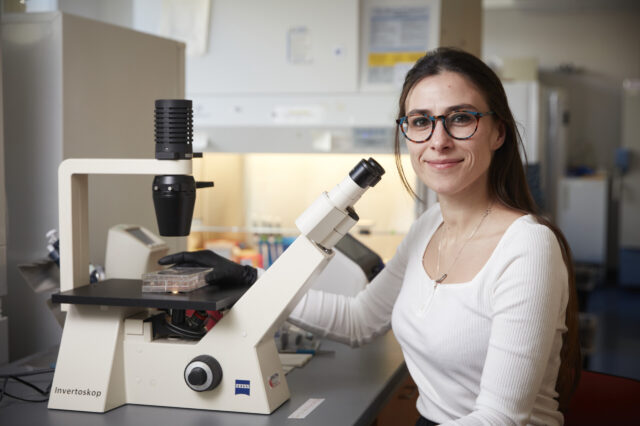Fired up about neurons: New Wertheim UF Scripps scientist uncovers brain cell biology

JUPITER, Fla. — Science can lead to surprising places.
Ezgi Hacisuleyman, Ph.D., had not intended to study the brain. Rather, she wanted to understand how cells organized themselves at the molecular level to carry out the business of life. Neurons proved to be especially interesting test subjects.
As she establishes her first independent lab at The Herbert Wertheim UF Scripps Institute for Biomedical Innovation & Technology, Hacisuleyman is inventing new ways to document the changes to neurons before and after they fire — and discovering many new facts about learning in the process. Long term, she hopes to apply her techniques and discoveries to better understand low-functioning autism.
Still, she considers herself an RNA biologist first.
“What we’re trying to do is actually look at synapses,” Hacisuleyman said. “They can be so far away from the nucleus, where all the DNA is kept. But it’s where all these exciting things happen, where neurons communicate with each other, where it’s energetically demanding. There are milliseconds where they have to respond to stimuli.”
Neurons have adapted to this demand in a variety of ways, such as allowing protein construction to happen at the farthest reaches of the neurons’ arms. Hacisuleyman developed a technique in cultured neurons that allows her to see how this happens. It makes it possible to compile inventories of all the proteins, RNAs and other cell factors near the synapse before and after signaling.
“The advantage of our technique is it allows us to see how neurons make the right proteins at the right time and location, as they would do in the living brain,” she said.
While DNA contains the recipes for life, RNA in its many forms makes the recipes. For her doctoral thesis project at Harvard University, Hacisuleyman and her adviser, John Rinn, Ph.D., discovered a new type of long non-coding RNA, or lncRNA for short. They named their lncRNA Firre and spent years investigating what Firre did within the cell and how it did it. It has since been described as a potential tumor promotor.
“This lncRNA was in the nucleus, where it was responsible for organizing multiple chromosomes into one location to regulate them in time and space,” Hacisuleyman said. “That work was very exciting to me. It led me to dig deeper.”
She marveled at how efficiently a cell manages itself.
“We have all these organelles; they are like tiny domains where things happen that are almost independent from the rest of the cell. So that led me to the question, how do these domains really organize themselves within cells?”
Neurons are an especially challenging and intriguing cell type, she said. If a neuron resembles a tall tree in a dense forest, its base would be the cell body, surrounded by root-like dendrites. Its trunk would be the neuron’s axon, and the tips of its farthest branches its axon terminals. These terminals reach toward the dendrites of nearby neurons. Separating axon from neighboring dendrite is the synapse, the place where electrochemical signals pass.
During postdoctoral studies with Jonathan Weissman, Ph.D., then at the University of California, San Francisco, Hacisuleyman learned a technique for documenting where ribosomes, protein-building machines, localize within cells. In neurons, there are many protein-building machines at synapses, because there’s simply no time for necessary proteins to travel from the cell body. That intrigued her.
For her second postdoctoral position, she moved to New York City, and joined the lab of Robert Darnell, Ph.D., at Rockefeller University. There, she perfected techniques for logging the RNAs and proteins near the synapse both before and after signaling.
“The technique that we developed has allowed us to discover really cool things about neuron biology, which will be published soon,” she said.
Applying her discoveries to better understand low-functioning autism is a far-off goal, but she’s says she has the right tools — and questions — to get started.
“One of the things that goes wrong in autism is the neurons’ ability to synthesize the right proteins in time and space. It just goes really wrong,” Hacisuleyman said. “There’s so much we still need to understand.”
The Wertheim UF Scripps Institute is an ideal place to move research discoveries toward clinical usefulness, and closer to people who might benefit, she said. Hacisuleyman arrived at The Wertheim UF Scripps Institute well-prepared. She earned her undergraduate degree with majors in chemical engineering, molecular biology and genetics from the Massachusetts Institute of Technology. She earned a doctorate in molecular biology and biochemistry from Harvard University.
The Wertheim UF Scripps Institute and the University of Florida feel like an ideal place to start her own lab and conduct fundamental and translational research, she said.
“In this campus there is such a diversity of scientists,” she said. “The resources are incredible. You’ve got Max Planck and the incredible microscopes. There’s an incredible group of people who support you here.”